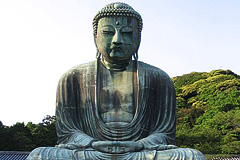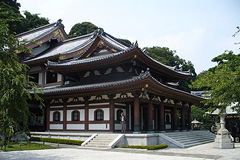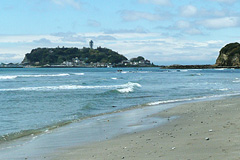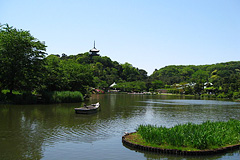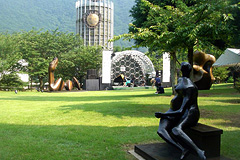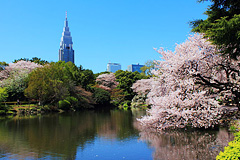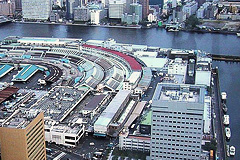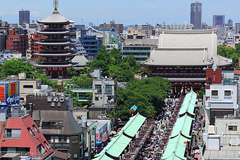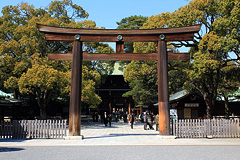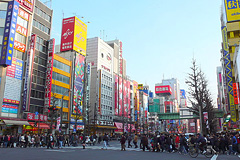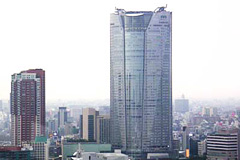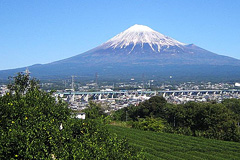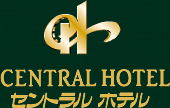- HOME
- >
- Sightseeing
-
Kotoku-in Temple(Great Buddha of Kamakura)
It is not known when it was built or by whom, but the Great Buddha of Kamakura is the second largest of its kind in Japan and a National Treasure. Officially, it is a principle image of Amida Nyorai (Amitabha Buddha). From the ground, it is 13.35 m tall. The face is 2.35 m long, the eyes 1 m long and the ears 1.9 m long. The whole statue weighs about 121 t. The original statue that sat here was made of wood, but was destroyed by a typhoon. The temple and statue seen today were rebuilt in 1712.
〈address〉4-2-28 hase, Kamakura, Kanagawa
〈Access〉 Take the JR Yokosuka Line to Kamakura Station. Change to the Enoshima Electric Railway for Fujisawa, and get off at the 3rd stop (Hase Station, about 7 min). About 7 min on foot from there.
-
Hasedera Temple(Hasekannon)
This is the fourth temple of the 33 Bando Holy Sites. Here you can see the largest wooden statue of Buddha, which is more than 9 m tall, and a Buddhist bell that has been designated an Important Cultural Property. The temple worships Daikokuten, one of the 7 deities of good fortune associated with Kamakura. The temple was built by the Holy Priest Tokudo with funding from Fusasaki Fujiwara of the Fujiwara Clan.
〈address〉3-11-2 hase, Kamakura, Kanagawa
〈Access〉 Take the bus from JR's Kamakura Station.
-
Enoshima
This small island is great for sightseeing and fun, as it has a rich history that includes a nude statue of the goddess of art and wisdom, Benten, and a yacht harbor and botanical gardens.
〈address〉Fujisawa, Kanagawa
〈Access〉 Katase-Enoshima Station, Odakyu Electric Railway Enoshima Station, Enoshima Electric Railway Shonan-Enoshima Station, Shonan Monorail
-
Sankeien Garden
This humongous Japanese garden covers 180,000 m2 of land. It belonged to Sankei Hara, a businessman and lover of the arts who made his money in the silk trade. Located on the grounds, the Rinshunkaku villa and the 3-tier Pagoda of the former Tomyoji Temple have been designated Important Cultural Properties. The gardens are well known for the plum and cherry blossoms, azaleas and autumnal foliage, and are very popular amongst visitors from overseas.
〈address〉58-1 Honmokusannotani, Naka, Yokohama, Kanagawa
〈Access〉 Negishi Station, JR's Keihintohoku Line/Negishi Line City Bus Nos. 58, 99 or 101 from Platform No. 1 (10 min) Get off at Honmoku Bus Stop. 10 min on foot from there.
-
The Hakone Open-Air Museum
This was the first sculpture garden in Japan. It was built to strike a harmony between the arts and great outdoors by the Fuji Sankei Group in 1969. Visitors can enjoy strolling about the vast 70,000 m2 grounds enjoying the seasonally changing landscape and some 120 works of modern art by masters such as Rodin, Moore and Miró. There are also 5 indoor galleries such as the Picasso Pavilion where the collection of over 300 works is regularly rotated. And, there are works that children can go in and play, and a 20 m long footbath of flowing hot spring water from which visitors can admire the artwork while soaking their feet.
〈address〉1121 Ninotaira, Hakone-machi, Ashigara, Kanagawa
〈Access〉 JR Odawara Station → Hakone Yumoto Station → Take the Hakone Tozan Railway to Chokoku-no-mori Station. 2 min on foot from there.
-
Shinjyuku Gyoen National Garden
These National Gardens are found in the northwest corner of the Meijijingu Gaien Park. They were originally built as an imperial garden in May 1879, but were opened to the general public after the war. On the grounds are a systematically arranged French garden near the former entrance (Sendagayamon Gate), a vast grassy field typical of the English countryside in the center and a traditional Japanese garden surrounding a pond towards the rear. The site is vast and is crowded on the weekends with people seeking this oasis in the city.
〈address〉11 Naito-machi, Shinjyuku, Tokyo
〈Access〉 Shinjukumon Gate: 10 min on foot from the South Exit of Shinjuku Station, JR, Keio Railway or Odakyu Electric Railway
-
Tsukiji Market
This is one of the largest markets selling seafood and produce in Japan. It is divided into indoor and outdoor markets, but the indoor market alone is about 231,400 m2 in size and is visited by about 50,000 shoppers every morning. Outside the market are found rows of sushi shops and other eateries that source fresh ingredients from the market. It is a great place to walk, nibble and revel in the freshness and energy. Some call it the "kitchen of Tokyo" where auctioneers gather early hours of the morning.
〈address〉5-2-1 Tsukiji, chuo, Tokyo
〈Access〉 Just outside the Tsukiji-Shijo Station of the Oedo Subway Line.
-
Senso-ji Temple
This renown area of Tokyo gives visitors a glimpse of Japan in the Edo Period with its large lantern hanging over the entrance and the rows of shops lining the approach to the temple. The current main temple was rebuilt in reinforced concrete in 1958. It is one of Asakusa's temples and shrines that worship the 7 deities of good fortune.
〈address〉2-3-1 Asakusa, Daito, Tokyo
〈Access〉 6 min on foot from Asakusa Station
-
Meiji Jingu Shrine
Built in 1920, this shrine is dedicated to the Meiji Emperor and Empress. The current structure was rebuilt in 1958. The grounds are divided into outer gardens and an inner sanctuary, with trees from across Japan, the Korean Peninsula and Taiwan systematically planted in the inner sanctuary. In 1970, the number of trees was increased to 170,000, so the site is literally a forest amidst the concrete jungle of the metropolitan area. The outer gardens have sports facilities including a baseball stadium, tennis courts, driving range, futsal courts and more. And, outer gardens are also known for their world famous gingko trees.
〈address〉1-1 Kamizono-cho, Yoyogi, Shibuya, Tokyo
〈Access〉 Harajyuku Gate<South entrance>:JR Yamanote Line「Harajyuku」station
Tokyo Metro Chiyoda Line・ Fukutoshin Line「Meijijingu-mae<Harajyuku>」Station -
Akihabara Electric Town
Nicknamed "Akiba," this inner-city commercial hub features some 6,000 stores selling every kind of electric product imaginable from audio equipment and computer parts to home appliances and PCs. It also has many video game and anime stores, so it is said to be a geek's paradise.
〈address〉Sotokanda Neighborhood, Chiyoda, Tokyo
〈Access〉 Get off at Akihabara
-
Roppongi Hills
This is a new place in Tokyo. Originated from plans hatched 17 years ago, it was born in April 2003 as the largest redevelopment project in Japan led by the private sector. It is a concentration of hotels, movie theaters, shopping malls, museums and buildings with great observation decks, centered around the landmark Roppongi Hills Mori Tower. There are many stores, restaurants and specialties that can be found only here, thus putting unspoiled extravagance in the palm of your hand.
〈address〉6 Roppongi, Minato, Tokyo
〈Access〉 Just outside Roppongi Station on the Hibiya Subway Line, or 4 min on foot from Roppongi Station on the Oedo Subway Line.
-
Tokyo Disneyland
Tokyo Disneyland is a world of magical fun for children and adults alike. Each of the zones feature themed attractions. Even details such as trees, benches and trashcans are designed to represent the world of Disney.
〈address〉1-1 Maihama, Urayasu, Chiba
〈Access〉 (1) 7 min on foot from JR's Maihama Station(2) Take the bus from Urayasu Station.
-
Mount Fuji
Fujisan, as it is known in Japan, is an active volcano. Rising 3,776 m in elevation, its elegant silhouette is widely known not only in Japan but around the world as the symbol of this great nation. It has often been the subject of artwork and strongly influenced artistic trends. It consists of layers of basalt rock that form catenary curves and reach as far away as the shoreline in Suruga Bay. It was registered as a World Heritage in 2013.
〈Access〉 With JR Chuo Line for Shinjyuku(Limited express),Fuji Kyuko Line get off at Kawaguchiko Station.
















